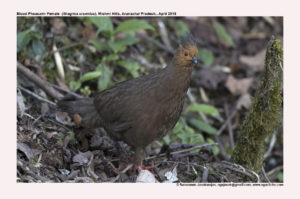
Blood Pheasant Ithaginis cruentus
Etymology :
- Ithaginis : Greek word ithagenes – true-born, noble.
- Cruentus : Latin word cruentus- bloody
Vernacular Names :Mishmi: Chiku, Lepcha: Same, Semo, Soomoog pho, Nepal: Chilime, Chilimili, Seremin, Selmung, Tibetan: Siri, Seto
Distribution in India: Resident of Himalayas in India.
Description: Size of male is 44–48 cm, tail size 16·5–18 cm; female size 39·5–42 cm, tail size is 14–15·5 cm; Wt. of 410–655 g. It has the size of a small fowl, with a short convex, very strong black bill, feathered between bill and eye, and a small crest of various coloured feathers. The colour of the plumage above is dark ash, with white shafts; the coverts of the wings are tinged with green, with broad strokes of white through the length of each feather, the feathers of the chin deep crimson. On the breast, belly and sides feathers are lance-shaped, of various length, the tips green with crimson margins, collectively resembling dashes of blood scattered on the breast and belly. The tail consists of twelve sub-equal feathers, shafts are white, rounded, the ends are whitish, the coverts are rich crimson red. Both males and females have red feet and a distinct ring of bare skin around the eye that typically is crimson colored, but is orange in a few subspecies. Females are more uniformly colored, being overall dull brown and often with some gray to the nape. The sub-species mainly vary in the plumage of the males, especially the amount of red or black to the throat, forehead, neck, chest and tail, and the presence or absence of rufous in the wings.
Habitat: It is found in high-altitude rhododendron scrub and other types of subalpine ,in pine and juniper forests, and in bamboo forest. It prefers areas close to water. It is found from 2550–4500 m.
Food habits: It eats moss, leaf litter and grass shoots and insects. In autumn, it feeds on small fruits, leaves, seeds, moss spore cases, bamboo shoots, berries and rose pips. In winter, diet is fir and juniper shoots, berries, moss and bamboo leaves. After heavy snow, it is seen feeding on lily seed cases and associated insects. It feeds by scratching on ground. It feeds arboreal on moss-covered branches, but also digs through snow. During the incubation period males are more vigilant than females and females spend more time feeding than males, with female behaviour related to male vigilance.
Breeding habits : They breed in Apr to June. They are mostly monogamous, but polygamy and polyandry are also seen. The nest is a depression in ground, lined with dead grass stems. They lay a clutch of 2–7 eggs. The incubation period is 35-37 days and incubation done by female alone, which usually takes single break per day, but this lasts > 6 hours during which time eggs regularly experience embryonic hypothermia. Both adults tend chicks.